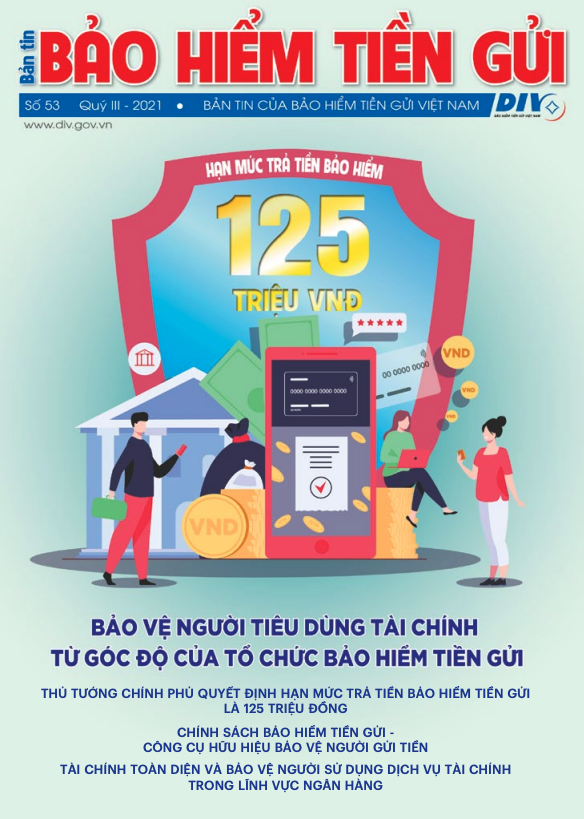Successfully implemented the flat-rate premium
The Law on deposit insurance stipulates that the deposit insurance premium is the amount that the insured institution must pay to the Deposit Insurance of Vietnam (DIV) to insure the deposit of insured depositors. According to the provisions of the Law on deposit insurance, the deposit insurance premium framework is set by the Prime Minister at the request of the State Bank of Vietnam (SBV). Based on the premium framework, the SBV shall stipulate a specific deposit insurance premium rate for insured institutions on the basis of the results of assessment and classification of such institutions.
Clause 3, Article 21 of Decree No.68/2013/ND-CP stipulates that: “The regulations on deposit insurance premiums and the amount of insurance to be paid under Decree No.89/1999/ND-CP dated September 1, 1999 on deposit insurance and Decree No.109/2005/ND-CP dated August 24, 2005 amending and supplementing a number of articles of Decree No.89/1999/ND-CP shall continue to be effective until the Prime Minister promulgates the regulations on deposit insurance premium framework, coverage limit in accordance with the provisions of the Law on deposit insurance”.
In Vietnam, the deposit insurance premium is equal to 0.15% per year calculated on the average deposit balance of all types of insured deposits at the insured institution. This premium has been applied since the establishment of DIV until now. DIV is responsible for calculating and collecting deposit insurance premiums from insured institutions.
After more than 20 years of implementing deposit insurance activities, it can be affirmed that Vietnam has successfully implemented the flat rate, which is reflected in three aspects: Relatively harmonious contribution level between the partners participating in the deposit insurance; not creating too great financial liability for the insured institutions; and relatively suitability to the conditions and development level of insured institutions in Vietnam.
Currently, in Vietnam, there are 1,283 organizations participating in deposit insurance, including 97 banks and foreign bank branches, 1,181 people's credit funds, 01 cooperative bank and 04 microfinance institutions. The insured institutions have large differences in their development process, size and scope of operation. With the fact that customers have such large differences, it is a very difficult requirement to ensure that the fees of the same rank create a relatively fair treatment of financial contributions among them. However, the regulation on calculating deposit insurance fee that has been applied frequently in the past time on the basis of selecting the premium deposit balance as insured deposit, has created a relatively fair treatment for financial contributions between insured institutions and there is support for institutions that are new to the currency business. This can be assessed as a great success of applying flat rate deposit insurance premiums in the early years of deposit insurance policy implementation.
The need for a roadmap to apply differential deposit insurance premiums
Equal competition and integration pose a requirement to eliminate incentives and discrimination in business. The outstanding advantage of the flat rate deposit insurance premium is its ease of implementation. Since all insured institutions are subject to the same rate, the need for an accurate assessment of the performance of the insured institution is not necessarily in the consideration of financial responsibility of the insured institution to the deposit insurer. This advantage has created great favorable conditions for the deposit insurer, especially in the early stages of implementing deposit insurance activities. Therefore, the majority of deposit insurance systems in the world start with the application of financial contributions according to the flat rate of deposit insurance premiums.
In addition, the flat rate deposit insurance premiums also reveal some basic limitations that need to be studied and planned to overcome. Specifically, the flat rate of deposit insurance premiums applied to all customers participating in deposit insurance will create the possibility of manifestations of dependence from a risk management perspective in the activities of insured institutions, and at the same time does not have the effect of encouraging them to emulate good and safe operation in order to apply a lower deposit insurance premium rate. Moreover, the deposit insurance premium is also one of the announcement signals to the market about the operation status of the insured institutions, especially the level of business risks. That poses a requirement to consider, step by step, to apply differential deposit insurance premiums.
Although some activities of a deposit insurer are relatively independent, the feasibility of implementing a differential deposit insurance premium in a deposit insurer's operations is highly dependent on developments in a number of other areas in the economy. These are the areas related to the system of independent evaluation of the activities of deposit mobilization units; the development of the money market; development of audit activities. The activity of these sectors is a necessary condition for making differential deposit insurance premiums possible.
The deposit insurer, when developed to a certain level, may be able to evaluate the activities of the insured institution with a high degree of accuracy. However, for a deposit insurer to do so independently, it requires human resources, specialized skills in many industries, and a fairly long time.
Therefore, in order to gradually achieve the goal of applying differential deposit insurance premiums, it is necessary to study and fully assess the level of risk in the operation of each insured institution. In addition, to achieve the necessary consistency between the assessment of the deposit insurer and other authorities on the level of risk in the activities of the insured institutions, it is necessary to carry out successive steps. The differential deposit insurance premium development plan has a relatively complete level of development that is appropriate to each period of development in the activities of insured institutions and other evaluation standards.
From the above analysis, it can be confirmed that the differential deposit insurance premium helps ensure fairness and encourages insured institutions to enhance risk management and improve operational quality. However, the application of the differential premium system needs a suitable roadmap, which requires full and careful research to avoid negative impacts on the system of credit institutions, affecting the trust of customers and the stability of credit institutions. The transition from a flat rate to a differential deposit insurance premium requires an assured transition period from the announcement of the differential premium system until the practical application that is sufficient for the insured institutions to adjust their operations in order to achieve the low fees; and enough time for the regulator to conduct a trial calculation and assess the impact of the application of the differential premium system on the banking system. The appropriate time to apply the differential deposit insurance premium system is when all the prerequisites for its application have been met and there is sufficient legal basis to support the implementation of such premium system.



























